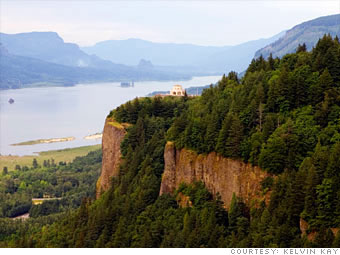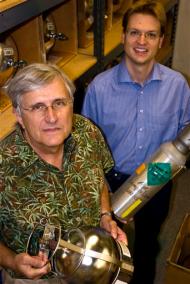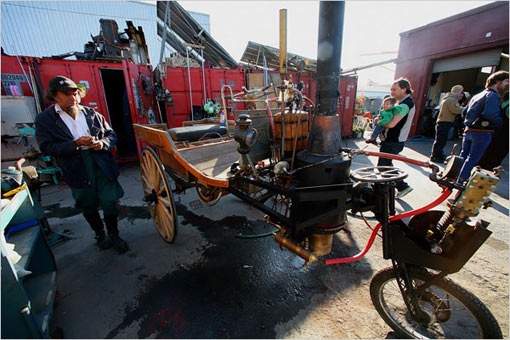You are hereHealth & Lifestyle
Health & Lifestyle
A greenhouse gas 17000 times more potent than CO2: NF3 gas used in making flat panel TVs, computer displays, microcircuits

(quote)
A gas used in manufacture of flat panel televisions, computer displays, microcircuits, and thin-film solar panels is 17,000 times more potent a greenhouse gas than carbon dioxide, and it is four times more prevalent in the atmosphere than previously estimated, according to a study released Thursday. Researchers using a new NASA-funded measurement network discovered there was 4,200 metric tons of the gas nitrogen trifluoride in the atmosphere in 2006, not 1,200 tons as previously estimated for that year.
In 2008 there are 5,400 metric tons of the gas in the atmosphere, an average of an 11 percent tonnage increase per year, said Ray Weiss, head of the research team from the Scripps Institution of Oceanography in La Jolla, California. Nitrogen trifluoride, which could not be detected in the atmosphere using previous techniques, is 17,000 times more potent as a global warming agent than a similar mass of CO2. The rate of increase means that about 16 percent of the amount of the gas produced globally is being emitted into the atmosphere, the researchers estimate.
Inventors in 800mi car race run on wood chips, cow dung, veg oil, no gas! Jagged Sierra Nevada, bleak flatness of Death Valley

(quote)
Wayne Keith, a hay farmer from Springville, Ala. (population 3,000), pulled into Berkeley last week driving a lime-green pickup truck that runs mostly on wood chips but sometimes cow dung, too. Keith, who wore dirt-flecked overalls and a trucker's cap, was in town to compete in the first Escape from Berkeley race, a kind of mini Cannonball Run to Las Vegas for drivers of vehicles that run on anything but petroleum. Two other racers relied on vegetable oil, one on alcohol and one on steam power to run his carriage (mostly for show; after a few miles, it was put on a trailer to traverse some of the dicier terrain).
Techies' new frontiers: Portland OR, Bethlehem PA, Blacksburg VA, Bellevue WA, Boise ID, Folsom CA

(quote)
Portland, Oregon
Some people call it Silicon Forest. That's because the Portland metropolitan area has done an impressive job of attracting entrepreneurial tech talent, thanks in part to the presence of Tektronix, IBM and Intel. In fact, many of the city's computer-technology companies were started by former employees of these tech giants, focusing on areas such as open-source and educational software. But Portland isn't just about computer technology. Over the years, the city has earned a reputation for progressive energy policies, attracting a large sustainable-technology community, as well as the U.S. headquarters of Vestas, the world's largest wind-turbine manufacturer. Support for the Portland tech scene comes from organizations such as Oregon InC, a state-funded venture dedicated to nurturing Oregon's innovation economy.

Bethlehem, Pennsylvania
With the decline of its steel industry over the past two decades, Bethlehem has worked hard to encourage its burgeoning local tech community. Numerous startups have sprouted in recent years, thanks in part to the city's two hospitals and two local colleges. New technologies currently in development range from computer chips to instruments used in truck-tire manufacturing. Ben Franklin Technology Partners, a state-funded program based in Lehigh University, works with early-stage tech firms across 19 counties, awarding grants and helping companies find everything from funding to skilled workers and technology. The city also provides support, working with local groups to offer low-interest loans and enterprise-zone incentives. read more »
Monks and nuns become hoteliers in economically challenging times: monastic doors open for travelers in Europe

(quote)
When Kathleen Mazzocco was researching places for an affordable family vacation in Italy back in 2002, booking a room in a convent was “like shooting in the dark.” The guidebook to religious lodgings that Ms. Mazzocco used had no photographs, and she wasn’t sure the information was up-to-date. But by the time Ms. Mazzocco, a public relations consultant from Lake Oswego, Ore., returned to Italy last year, making a reservation at a monastery was not so different from booking a regular hotel. She found the cliffside Monastero S. Croce, in Liguria, on the Internet, viewed photos of it on the monastery’s own Web site, sent an e-mail message asking about availability, heard back promptly, and, at the end of her stay, paid with a credit card. “They’d entered the modern age,” she said.

For centuries Europe’s convents and monasteries have quietly provided inexpensive lodging to itinerants and in-the-know travelers, but now they’re increasingly throwing open their iron-bound doors to overnight visitors. They’ve begun Web sites - many with English translations and detailed information about sampling monastic life for a night - and signed on with Internet booking services. Some have even added spa offerings. Occupancy has shot up at many places, and some of the more centrally located are often fully booked. read more »
Convenience at a cost. Bottled water no less polluted than kitchen tap, in addition to plastic pollution

(quote)
Bottled water sold in markets and convenience stores may be no more free of pollutants than the water that pours from the kitchen tap at a fraction of the cost, said an environmental group that tested samples. Ten top-selling brands of bottled water contained a total of 38 pollutants including fertilizer, industrial chemicals, bacteria and the residue of drugs such as Tylenol, according to a report by the Environmental Working Group based in Washington, D.C. The bottled water showed an average of eight pollutants in each sample.
Americans drank more than twice as much bottled water in 2007 as they did in 1997, guzzling 8.8 billion gallons at a cost of $10.3 billion in 2007, according to the Beverage Marketing Corp., a research and consulting firm based in New York. Although commercials often show pristine mountain springs, the reality is that bottled water often comes from city water supplies, said Renee Sharp, an Environmental Working Group senior scientist. "If you're going to pay 1,500 times more for bottled water than for tap you'd expect that you'd be getting a cleaner, better product," said Sharp. "And that's not necessarily true."
Jet plane to fly on algae-based fuel by 2010? Europe’s algae bloom aims for feasible alternative to fossil fuel

(quote)
"It's exciting because it's achievable," says Peter van den Dorpel, as he looks over the big plastic tubes full of various shades of green algae. His company has designed, produced and marketed the crop in its bid to be the first to provide the aviation industry with a feasible alternative to fossil fuel. In an enormous greenhouse near Roosendaal in the south of The Netherlands, most of the greenhouse is growing tomatoes with impressive efficiency, with one corner dedicated to the cultivation of algae - in a similarly efficient way, according to Mr van den Dorpel. "It's actually like growing tomatoes; the algae need similar things," he says.

This crop uses the warmth, light and a steady feed of carbon dioxide and nutrients to reproduce faster than any other plant on earth. The amount of algae in these tubes can double daily. And that is both the attraction and the problem with algae as a commercial crop. What Algae-Link's system claims to crack, possibly for the first time, is the problem of clogging. A patented internal cleaning system keeps the set-up harvesting twenty-four hours a day.






















